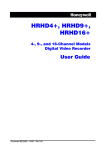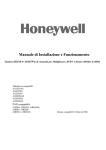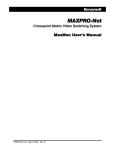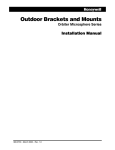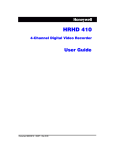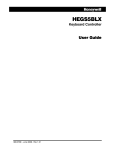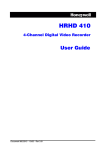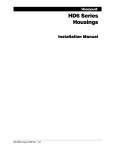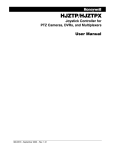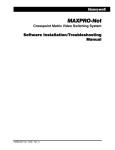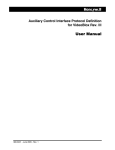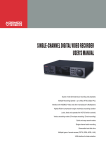Download HRHD series DVR RAS Guide
Transcript
RAS (Remote Administration System) Digital Video Recorder Software User Guide Document 900.0314 – 08/04 – Rev 1.00 RAS User Guide Revisions Issue Date Revisions 1.00 07/04 New document Contents About This Document. . . . . . . . . . . . . . . . . . . . . . . . . . . . . . . . . vii Overview of Contents . . . . . . . . . . . . . . . . . . . . . . . . . . . . . . . . . . vii Related Documents . . . . . . . . . . . . . . . . . . . . . . . . . . . . . . . . . . . viii 1 Overview . . . . . . . . . . . . . . . . . . . . . . . . . . . . . . . . . . . . . . 1 Features . . . . . . . . . . . . Before You Begin. . . . . . . . Package Contents . . . System Requirements . 2 . . . . . . . . . . . . . . . . . . . . . . . . . . . . . . . . . . . . . . . . . . . . . . . . . . . . . . . . . . . . . . . . . . . . . . . . . . . . . . . . . . . . . . . . . . . . . . . . . . . . . . . . . . . . . . . . . . . . . . . . . . . . . . . . . . . . . . . . . . . . 1 2 2 2 . . . . . . . . . . . . . . . . . . . . . . . . . . . . . . . . . . . . . . . . . . . . . . . . . . . . . . . . . . . . . . . . . . . . . . . . . . . . . . . . . . . . . . . . . . . . . . . . 3 3 3 5 . . . . . . . . . . . . . . . . . . . . . . . . . . . . . . . . . . . . . . . . . . . . . . . . . . . . . . . . . . . . . . . . . . . . . . . . . . . . . . . . . . . . . . . . . . . . . . . . . . . . . . . . . . . . . . . . . . . . . . . . . . . . . . . . . . . . . . . . . . . . . . . . . . . . . . . . . . . . . . . . . . . . . . . . . . . . . . . . . . . . . . . . . 7 . 9 .11 .11 .16 .18 .22 .25 RAS Watch . . . . . . . . . . . . . . . . . . . . . . . . . . . . . . . . . . . . . 29 Description . . . . . . . . . . . . . . . . . Functions of the RAS Watch . . . . . . . . Remote Sites/Connection Buttons Screen Mode Buttons . . . . . . . Full Screen Button . . . . . . . . Camera Buttons. . . . . . . . . . PTZ Control . . . . . . . . . . . Image Adjust Button . . . . . . . Rev 1.00 . . . . RAS Admin . . . . . . . . . . . . . . . . . . . . . . . . . . . . . . . . . . . . . 7 Description . . . . . . . . . . . . . . . . Emergency Event List . . . . . . Functions of the RAS Admin . . . . . . . Function Buttons . . . . . . . . Status Window for Remote Site Batch Job Setup Button . . . . . Local Setup Button . . . . . . . Log Buttons . . . . . . . . . . . 4 . . . . Installation and Operation. . . . . . . . . . . . . . . . . . . . . . . . . . . . . 3 Installation Procedures . . . . . Preliminary Procedures Install the Software . . Operating Procedures . . . . . 3 . . . . i . . . . . . . . . . . . . . . . . . . . . . . . . . . . . . . . . . . . . . . . . . . . . . . . . . . . . . . . . . . . . . . . . . . . . . . . . . . . . . . . . . . . . . . . . . . . . . . . . . . . . . . . . . . . . . . . . . . . . . . . . . . . . . . . . . . . . . . . . . . . . . . . . . . . . . . . . . . . . . . . . . . . . . . . . . . . . . . . . . . . . . . . .29 .31 .31 .33 .33 .33 .34 .34 Document 900.0314 08/04 Contents Alarm Out Control . . . Auto Sequencing Button Auto Connection Button Setup Button . . . . . . 5 . . . . . . . . . . . . . . . . . . . . . . . . . . . . . . . . . . . . . . . . . . . . . . . . . . . . . . . . . . . . . . . . . . . . . . . . . . . . . . . . . . . . . . . . . . . . . . . . . . . . . . . . . . . . . . . . .35 .36 .36 .37 RAS Search . . . . . . . . . . . . . . . . . . . . . . . . . . . . . . . . . . . . . 39 Description . . . . . . . . . . Timelapse Search . . . . . . . Event Search . . . . . . . . . Other Functions . . . . . . . Playback Functions . Screen Modes . . . . Image Enhancement . Save . . . . . . . . Print . . . . . . . . Display Setup . . . . Go To Date/Time . . Appendix A . . . . . . . . . . . . . . . . . . . . . . . . . . . . . . . . . . . . . . . . . . . . . . . . . . . . . . . . . . . . . . . . . . . . . . . . . . . . . . . . . . . . . . . . . . . . . . . . . . . . . . . . . . . . . . . . . . . . . . . . . . . . . . . . . . . . . . . . . . . . . . . . . . . . . . . . . . . . . . . . . . . . . . . . . . . . . . . . . . . . . . . . . . . . . . . . . . . . . . . . . . . . . . . . . . . . . . . . . . . . . . . . . . . . . . . . . . . . . . . . . . . . . . . . . . . . . . . . . . . . . . . . . . . . . . . . . . . . . . . . . . . . . . . . . . . . . . . . . . . . . . . . . . . . . . . . . . . . . . . . . . . . . . . . . . .39 .40 .41 .45 .45 .46 .46 .48 .50 .51 .52 MiniBank Self Player . . . . . . . . . . . . . . . . . . . . . . . . . . 53 Index . . . . . . . . . . . . . . . . . . . . . . . . . . . . . . . . . . . . . . . . . . . 1 Rev 1.00 ii Document 900.0314 08/04 Figures Figure 2-1 Welcome to Installation Wizard Screen . . . . . . . . . . . . . . . . . . . . . 4 Figure 2-2 Start Installation Screen . . . . . . . . . . . . . . . . . . . . . . . . . . . . . 4 Figure 2-3 Finish Installation Screen . . . . . . . . . . . . . . . . . . . . . . . . . . . . . 5 Figure 2-4 RAS 3-Button Toolbox. . . . . . . . . . . . . . . . . . . . . . . . . . . . . . 6 Figure 3-1 RAS Admin User Interface . . . . . . . . . . . . . . . . . . . . . . . . . . . . 8 Figure 3-2 Emergency Event List. . . . . . . . . . . . . . . . . . . . . . . . . . . . . . .10 Figure 3-3 Motion-Detecting Zone Setup Screen . . . . . . . . . . . . . . . . . . . . . .12 Figure 3-4 Remote System Log Screen . . . . . . . . . . . . . . . . . . . . . . . . . . .13 Figure 3-5 Remote Event Log Screen . . . . . . . . . . . . . . . . . . . . . . . . . . . .15 Figure 3-6 Batch Job System Check Screen . . . . . . . . . . . . . . . . . . . . . . . . .19 Figure 3-7 Batch Job Upgrade Screen . . . . . . . . . . . . . . . . . . . . . . . . . . . .20 Figure 3-8 Enter Filename Screen . . . . . . . . . . . . . . . . . . . . . . . . . . . . . .20 Figure 3-9 Batch Job Setup Screen. . . . . . . . . . . . . . . . . . . . . . . . . . . . . .21 Figure 3-10 Admin System Setup Screen . . . . . . . . . . . . . . . . . . . . . . . . . . .22 Figure 3-11 Admin Remote Site Setup . . . . . . . . . . . . . . . . . . . . . . . . . . . .23 Figure 3-12 Add a Site Screen . . . . . . . . . . . . . . . . . . . . . . . . . . . . . . . .24 Figure 3-13 IP Port Number Screen . . . . . . . . . . . . . . . . . . . . . . . . . . . . .25 Figure 3-14 Add a Group Screen . . . . . . . . . . . . . . . . . . . . . . . . . . . . . . .25 Figure 3-15 System Log Screen . . . . . . . . . . . . . . . . . . . . . . . . . . . . . . . .26 Figure 3-16 Batch Job Log Screen. . . . . . . . . . . . . . . . . . . . . . . . . . . . . . .27 Figure 3-17 Emergency Event Log Screen. . . . . . . . . . . . . . . . . . . . . . . . . . .28 Figure 4-1 RAS Watch User Interface . . . . . . . . . . . . . . . . . . . . . . . . . . . .30 Figure 4-2 Remote Sites List. . . . . . . . . . . . . . . . . . . . . . . . . . . . . . . . .32 Figure 4-3 Login Screen . . . . . . . . . . . . . . . . . . . . . . . . . . . . . . . . . . .32 Figure 4-4 PTZ Controls . . . . . . . . . . . . . . . . . . . . . . . . . . . . . . . . . .34 Figure 4-5 Image Enhancement Controls . . . . . . . . . . . . . . . . . . . . . . . . . .35 Figure 4-6 Alarm Out Control Panel . . . . . . . . . . . . . . . . . . . . . . . . . . . .35 Figure 4-7 Setup Favorites Screen . . . . . . . . . . . . . . . . . . . . . . . . . . . . . .37 Rev 1.00 iii Document 900.0314 08/04 Figures Figure 4-8 Setup Auto Sequencing Screen . . . . . . . . . . . . . . . . . . . . . . . . . .38 Figure 5-1 Timelapse Search User Interface . . . . . . . . . . . . . . . . . . . . . . . . .40 Figure 5-2 Go To Time Screen . . . . . . . . . . . . . . . . . . . . . . . . . . . . . . .41 Figure 5-3 Search By Event Screen . . . . . . . . . . . . . . . . . . . . . . . . . . . . .42 Figure 5-4 Search By Camera Screen . . . . . . . . . . . . . . . . . . . . . . . . . . . .43 Figure 5-5 Event Search User Interface . . . . . . . . . . . . . . . . . . . . . . . . . . .44 Figure 5-6 Image Enhancement Options . . . . . . . . . . . . . . . . . . . . . . . . . . .47 Figure 5-7 Choose Save Type Screen . . . . . . . . . . . . . . . . . . . . . . . . . . . .48 Figure 5-8 Save as Video File Screen . . . . . . . . . . . . . . . . . . . . . . . . . . . .49 Figure 5-9 Save as MiniBank Screen . . . . . . . . . . . . . . . . . . . . . . . . . . . . .50 Figure 5-10 On-Screen Display Setup Screen . . . . . . . . . . . . . . . . . . . . . . . . .51 Figure 5-11 Data Source Setup Screen . . . . . . . . . . . . . . . . . . . . . . . . . . . .52 Figure 5-12 Go To Time Screen . . . . . . . . . . . . . . . . . . . . . . . . . . . . . . .52 Figure A-1 MiniBank Self Player User Interface . . . . . . . . . . . . . . . . . . . . . . .53 Rev 1.00 iv Document 900.0314 08/04 Tables Table 3-1 RAS Admin Controls and Areas . . . . . . . . . . . . . . . . . . . . . . . . . 8 Table 3-2 Emergency Event Icon Descriptions. . . . . . . . . . . . . . . . . . . . . . . .10 Table 3-3 Motion-Detecting Zone Field Descriptions . . . . . . . . . . . . . . . . . . . .12 Table 3-4 System Log Icon Descriptions. . . . . . . . . . . . . . . . . . . . . . . . . . .14 Table 3-5 Remote Event Log Icon Descriptions . . . . . . . . . . . . . . . . . . . . . . .16 Table 3-6 Event Status Icon Descriptions . . . . . . . . . . . . . . . . . . . . . . . . . .16 Table 3-7 Alarm Out Status Icon Descriptions . . . . . . . . . . . . . . . . . . . . . . .17 Table 4-1 RAS Watch Controls and Areas . . . . . . . . . . . . . . . . . . . . . . . . .30 Table A-1 MiniBank Self Player Controls and Areas . . . . . . . . . . . . . . . . . . . . .54 Rev 1.00 v Document 900.0314 08/04 Tables Rev 1.00 vi Document 900.0314 08/04 About This Document This document introduces the Remote Administration System (RAS) software designed for the digital video recorder (DVR) and describes the procedures for operating and maintaining the software. Overview of Contents This document contains the following chapters and appendixes: Rev 1.00 • Chapter 1, Overview, describes the Remote Administration System and lists its features. • Chapter 2, Installation and Operation, provides the installation and operation procedures necessary for RAS use. • Chapter 3, RAS Admin, covers the functions and features of the RAS Admin program. • Chapter 4, RAS Watch, describes the functions and features of the RAS Watch program. • Chapter 5, RAS Search, describes the functions and features of the RAS Search program. • Appendix A, MiniBank Self Player, covers the functions and features of the MiniBank Self Player program. vii Document 900.0314 08/04 Related Documents For more information about topics that are relevant to the subject of this manual, see the documents listed below. Rev 1.00 Document title Part number HRHD4+, HRHD9+, HRHD16+ Series DVR User Guide 900.0258 HRHD410 DVR User Guide 900.0315 HRHD Single Channel DVR User Guide 900.0316 viii Document 900.0314 08/04 Overview 1 Overview Remote Administration System (RAS) software consists of the following programs: • RAS Admin. The main administration program • RAS Watch. A remote surveillance program • RAS Search. A remote search program After a successful installation, each program may be selected from the Windows task bar or the 3-button program Graphical User Interface (GUI). Features The RAS program is the integrated software that controls system management, video monitoring, and image playback of multiple remotely connected Digital Video Recorders (DVRs). RAS offers the following features: Rev 1.00 • Checking and reporting on the DVR status at a remote site • Notification of event detection from remote sites • Remote monitoring of live camera images • Searching timelapse and event recorded images • Remotely upgrading the software and programming the system 1 Document 900.0314 08/04 Overview Before You Begin Package Contents Please read this guide carefully before you install the RAS software. Keep this guide for future reference. Unpack everything. Check that the items you received match those listed on the order form and packing slip. The RAS packing box should include: • One User Guide • Installation disks System Requirements Playing back digital video puts a high demand on your computer system. To use the RAS video monitoring and playback functions, your personal computer (PC) must meet the minimum system requirements listed below: Rev 1.00 • Operating System: Microsoft® Windows® 98, Microsoft Windows ME, Microsoft Windows 2000, or Microsoft Windows XP • CPU: Intel Pentium II (Celeron) 266 MHz or higher • RAM: 64 MB or higher • VGA: AGP, Video RAM 8 MB or higher (1024 x 768, 24 bpp or higher) 2 Document 900.0314 08/04 Installation and Operation 2 Installation and Operation Installation Procedures Caution If an older version of RAS has already been installed on your computer, you should uninstall the older version before installing the new one. Preliminary Procedures 1. Under the Start menu in Windows, go to Settings and then to Control Panel. 2. Double click Power Options to open the Management Properties dialog box. 3. Select Never for the Turn off monitor and Turn off hard disks fields. Install the Software Rev 1.00 1. Insert the first installation disk. 2. Run the Setup.exe file. 3. When Figure 2-1 appears, click Next. 3 Document 900.0314 08/04 Installation and Operation Figure 2-1 4. Click Install. Figure 2-2 Rev 1.00 Welcome to Installation Wizard Screen Start Installation Screen 5. Follow the on-screen instructions to insert the next installation disks as required. 6. Make certain Yes, restart the computer now is selected, and then click Finish to reboot the system. This completes the installation. 4 Document 900.0314 08/04 Installation and Operation Figure 2-3 Finish Installation Screen Operating Procedures Rev 1.00 1. After installing the RAS software, you will find the RAS Server icon your PC desktop. 2. Run the RAS program by double clicking the icon. The main administration program—RAS Admin—will appear. 3. To activate one of the other programs using the 3-button GUI, click the right mouse button when the cursor is on top of the main displayed GUI. The 3-button toolbox (Figure 2-4) is shown. 5 on Document 900.0314 08/04 Installation and Operation Figure 2-4 RAS 3-Button Toolbox Close RAS Admin RAS Watch 4. Rev 1.00 RAS Search Each icon represents one of the three RAS programs: RAS Admin, RAS Watch, and RAS Search, as shown to the left. To exit and close the RAS program, click the Close button. 6 Document 900.0314 08/04 RAS Admin 3 RAS Admin Description RAS Admin, the main administration software of RAS, provides reporting functions including: • A live system status report and search • An event log search • A system log search and • Remote programming of the DVR. The Graphical User Interface (GUI) of the RAS Admin is shown in Figure 3-1 and the description of each control area follows. Rev 1.00 7 Document 900.0314 08/04 RAS Admin Figure 3-1 RAS Admin User Interface Status window Function Close Remote site list Batch job Batch job information window Emergency event Table 3-1 Emergency event list Local setup System log RAS Admin Controls and Areas RAS Admin Function Remote Site List Displays a list of remote sites registered in RAS Admin. Quit closes the RAS program. Function buttons Connect initiates a connection to the selected site in the remote site list. Watch initiates the RAS Watch program. If a site in the remote site list is selected, the RAS Watch program will open already connected. Search initiates the RAS Search program. If a site in the remote site list is selected, the RAS Search program will open already connected. Remote Setup allows remote changes to be made to the programming of a connected DVR. Remote System Log displays the system log information of a remotely connected DVR. Rev 1.00 8 Document 900.0314 08/04 RAS Admin Table 3-1 RAS Admin Controls and Areas RAS Admin (cont’d) Function Remote Event Log displays the event log information of a remotely connected DVR. Status Window Displays the status of the remote DVR currently connected (event detection, alarm out, system check, record period, and version information). Batch Job buttons Batch Job Setup opens the batch job setup screen for multiple remote sites. Batch Job Log displays the RAS batch job log information. Batch Job Information Window Displays the current batch job information. Emergency Event buttons Emergency Event Log displays the log information of emergency events. Watch opens the RAS Watch program for the selected emergency event. Search opens the RAS Search program for the selected emergency event. Emergency Event List Displays the event(s) that were called back from individual remote site (LAN connection only). The description of event icons and their meanings are included in Table 3-2. Local Setup opens the Setup—Admin dialog box which controls programming of the RAS Admin. System Log displays the system log. Emergency Event List The Emergency Event list displays event information from a remotely connected DVR on RAS when the recorders event action has notification enabled (see your DVR User Guide for information on setting up event actions). RAS must be set for callback (see Local Setup Button on page 22) for the DVR to be able to send event information to the RAS server. Rev 1.00 9 Document 900.0314 08/04 RAS Admin Figure 3-2 Emergency Event List Table 3-2 Emergency Event Icon Descriptions Icon Meaning Normal Event Emergency Event (preset to be notified at the remote DVR) Motion Detection Video Loss Alarm In Text In Alarm In Bad Recorder Bad Disk S.M.A.R.T. Disk Bad Disk Full Disk Temperature Note Rev 1.00 Event notification for Text In may not be supported, depending on the specifications of the remotely connected DVR. 10 Document 900.0314 08/04 RAS Admin Functions of the RAS Admin Function Buttons Connect Button Select the site you want to connect to from the Remote Site List, and then click Connect to initiate a connection (if required) and to display the system status of the connected system. If you want to connect to another site, disconnect from the currently connected system by re-clicking Connect. Watch/Search Buttons Initiates the RAS Watch or RAS Search programs. Select the site from the Remote Site List, and then click the Watch or Search buttons to activate the RAS Watch or RAS Search programs. The site you select will be connected directly. Note Clicking the Watch or Search buttons when no site is selected in the Remote Site List only activates the program without connecting to a site. DVR Setup Button Allows remote changes to be made to the programming of a connected DVR. Note Refer to the manual for each applicable remote DVR for the details of system programming and setup. To set up the Motion-Detecting Zone on your remotely connected DVR: Rev 1.00 1. Press DVR Setup. 2. Click Device at the top of the setup screen. 3. Click Motion Detector. 11 Document 900.0314 08/04 RAS Admin 4. Click the Zone field for the selected camera. 5. Figure 3-3, the Motion-Detecting Zone Setup dialog box displays. Select the zones on the screen that will detect motion. See Table 3-3 for information on selecting and changing the Motion-detecting zone. Figure 3-3 Motion-Detecting Zone Setup Screen Table 3-3 Motion-Detecting Zone Field Descriptions Icon Function Activates the target area for the motion-detecting zone. Releases the target area from the motion-detecting zone. Select the block(s) for the motion-detecting zone by dragging the mouse. Select the rectangle-shaped blocks for the motion-detecting zone. Select all blocks for the motion-detecting zone. To select zones for motion detection: Rev 1.00 1. Select the mode button between activating and releasing the target area to set up the motion-detecting zone. 2. Select the area to set or release using one of the three selection tools. 12 Document 900.0314 08/04 RAS Admin Caution When using a dial-up modem for remote connection, the current connection to the RAS Watch will be disconnected if you initiate the motion-detecting zone setup. After setting up the motion detection, connect to the target site again. Remote System Log Button Displays the system log information of a remotely connected DVR (see Figure 3-4). If you set a time period of interest and click Find, the system log entries within that time period are displayed in the list. A total of 100 results can be displayed in the list at one time. To scroll through the list, click Next ( ). Figure 3-4 Rev 1.00 Remote System Log Screen 13 Document 900.0314 08/04 RAS Admin • From: If this box is checked, the search begins from the first remote system log entry. If you want to search a specific starting date/time, remove the check mark and then set the desired date/time. • To: If this box is checked, the search continues until the last remote system log entry. If you want to search a specific ending date/time, remove the check mark and then set the desired date/time. • Find: Displays remote system log entries within the set time period. Table 3-4 Icon System Log Icon Descriptions Function First: Moves to the first page of the found log entries. Previous: Moves to the previous page. Next: Moves to the next page. Last: Moves to the last page of the found log entries. • Save: Saves the log information to a text file. • Print: Prints the log information to a connected printer. • Close: Closes the dialog box. Remote Event Log Button Displays the event log information of a remotely connected DVR. If you set a time period of interest and click Find, the event log entries within that time period are displayed in the list. A total of 100 results can be displayed in the list at one time. To scroll through the list, click Next ( ). Rev 1.00 14 Document 900.0314 08/04 RAS Admin Figure 3-5 Rev 1.00 Remote Event Log Screen • From: If this box is checked, the search begins from the first remote event log entry. If you want to search a specific starting date/time, remove the check mark and then set the desired date/time. • To: If this box is checked, the search continues until the last remote event log entry. If you want to search a specific ending date/time, remove the check mark and then set the desired date/time. • Find: Displays remote system log entries within the set time period. 15 Document 900.0314 08/04 RAS Admin Table 3-5 Icon Remote Event Log Icon Descriptions Function First: Moves to the first page of the found log entries. Previous: Moves to the previous page. Next: Moves to the next page. Last: Moves to the last page of the found log entries. • Save: Saves the log information to a text file. • Print: Prints the log information to a connected printer. • Close: Closes the dialog box. Status Window for Remote Site Event Displays the events detected by the internal motion detector, external sensor, or text-in transaction. The status display of event detection continues during the preset dwell time of the event-driven recording. The icons of each status are as follows: Table 3-6 Event Status Icon Descriptions Event Type Event Status Event Detection No Event Detection Event Off Motion Detection Sensor (bright) (bright) (dim) (dim) (dark) (dark) Alarm Out Displays the status of the alarm-out signals. The icons of each status are as follows: Rev 1.00 16 Document 900.0314 08/04 RAS Admin Table 3-7 Alarm Out Status Icon Descriptions Icon Status Alarm Out (bright) No Alarm Out (dim) System Check Displays the function status of the cameras, alarms, and recording of the remotely connected DVR. The icons of each status are as follows: System Component Component Status Camera Alarm Recording Normal Irregular System Check Off Record Period Displays the record period information. Brackets next to the record period information show the operating mode of a remotely connected DVR (Record, Playback or Backup). • When the DVR is in Simplex mode (the DVR is set to record but will stop recording when playing back clips), RAS displays Playback as the operating mode. • When the DVR is in Duplex mode (the DVR is set to record and can play back clips without interrupting recording), RAS displays Record as the operating mode. • When the DVR is not set up for recording, RAS displays Backup as the operating mode. Note Rev 1.00 If the remote DVR is in playback mode (Simplex mode), all status icons turn to the Off mode. 17 Document 900.0314 08/04 RAS Admin Version Displays hardware and software version information. Batch Job Setup Button Set up the batch job of a System Check (Figure 3-6), remote Upgrade (Figure 3-7), and remote Setup (Figure 3-9) for multiple remote sites. Batch jobs are designed to perform a system check, upgrade recorder firmware or setup multiple remotely connected DVRs at one time. For example, you could use the System Check batch job to check the status of all recorders in your system without having to connect to each one individually. Note Batch jobs cannot be run or setup while you are connected to a site. Disconnect from any connected site to access the batch job options. System Check Set up the system check job for remote sites: Rev 1.00 1. Select the remote site to check from the Registered sites field, and add it to the Target sites field by clicking Add or Add all to select all of the registered sites. 2. Click System check now... to initiate the system check job for the target site(s). 18 Document 900.0314 08/04 RAS Admin Figure 3-6 Batch Job System Check Screen • Add: Adds the selected site from Registered sites to Target sites. • Add all: Adds all the sites in Registered sites to Target sites. • Remove: Removes the selected site from Target sites. • Remove all: Removes all the sites from Target sites. • System check now: Checks the system(s) on the target remote site(s). Upgrade Set up the remote upgrade job for remote sites: Rev 1.00 1. Select the remote site to upgrade from the Registered sites field, and add it to the Target sites field by clicking Add or Add all to select all of the registered sites. 2. Click Upgrade now... to initiate the remote upgrade job for the target site(s). 3. The Enter File Name screen opens (see Figure 3-8). Click browse ( ) to search for the DVR upgrade image file, or enter the filename and click OK. 19 Document 900.0314 08/04 RAS Admin Figure 3-7 • Add: Adds the selected site from Registered sites to Target sites. • Add all: Adds all the sites in Registered sites to Target sites. • Remove: Removes the selected site from Target sites. • Remove all: Removes all the sites from Target sites. • Upgrade now: Upgrades the software on the target remote site(s). Figure 3-8 Rev 1.00 Batch Job Upgrade Screen Enter Filename Screen 20 Document 900.0314 08/04 RAS Admin Setup When using the Setup Batch Job, some jobs will e skipped as the cannot be done as a batch (setting up IP addresses for example). Set up the remote setup job for remote sites: 1. Select the remote site to set up from the Registered sites field, and add it to the Target sites field by clicking Add or Add all to select all of the registered sites. 2. Click Setup now... to initiate the remote setup job for the target site(s). 3. The Enter File Name screen opens (see Figure 3-8). Click browse ( ) to search for the setup file saved during remote setup, or enter the filename and click OK. Figure 3-9 Rev 1.00 Batch Job Setup Screen • Add: Adds the selected site from Registered sites to Target sites. • Add all: Adds all the sites in Registered sites to Target sites. • Remove: Removes the selected site from Target sites. • Remove all: Removes all the sites from Target sites. • Setup now: Sets up the target remote site(s). 21 Document 900.0314 08/04 RAS Admin Local Setup Button The Local Setup button initiates programming for system operation (Figure 3-10) and remote site configuration (Figure 3-11). System Set up the date/time format for RAS, the modem connection information for remote access, the system password, display, and network options. Figure 3-10 Rev 1.00 Admin System Setup Screen • Date/Time Format: Set the date/time format. • Dial-up Network: Select Use modem if you want to use the internal modem or an external modem for remote access. • Security Options: Set up password confirmation to be required Before setup, Before startup, or Before shutdown of RAS. Click Change to change the password. The password can be composed of up to 8 characters (case sensitive). 22 Document 900.0314 08/04 RAS Admin • Display Option: Set up the display acceleration. • None: Not using the display acceleration. • Normal: Using the display acceleration (DirectX). • Full: Using the display acceleration (DirectX Video Memory). Note • The image may not display properly. This could be a result of the specifications of your PC. In this case, lower the level of the display option. Network Option: Set up the IP port number (from 8000 to 12000) that is used for network connection when receiving a callback message from a remote site. The IP port number you enter should match the value set during the LAN setup on the remotely connected DVR. Remote Site Configure the connection list for remote access. Figure 3-11 Rev 1.00 Admin Remote Site Setup 23 Document 900.0314 08/04 RAS Admin 1. Click Add and enter the information of the remote site to be registered (see Figure 3-12). 2. Enter a Site name and the IP address of the remote site (or a modem phone number for dial-up connections), acquired from your network administrator. If you have entered a user ID and a remote site password for remote access, the site will connect automatically without you being prompted for a password. Note Up to 32 characters may be entered for the site name and telephone number, and eight characters entered for the password. Figure 3-12 Add a Site Screen 3. The box beside User ID can be disabled, depending on the RAS software version. 4. Click Port... and set up the IP port number of each program (see Figure 3-13). The IP port number you enter should match the value set during the LAN setup on the remotely connected DVR. If the remote DVR version does not allow you to set the IP port numbers, use the following values: 8200 for Admin, 8016 for Watch, and 10019 for Search. Rev 1.00 24 Document 900.0314 08/04 RAS Admin Figure 3-13 5. IP Port Number Screen For the effective management of multiple remote sites, we suggest you assign the site to a Reference Group. a. Click Add to make a new reference group (see Figure 3-14). The Add Group dialog box appears. b. Enter a group name to register. c. Click OK. Figure 3-14 Add a Group Screen To change a group or site, select the group or the site to change and click Change. And then change the site information. To remove a group or site, select the group or the site to remove and then click Remove. Log Buttons Displays the System Log (see Figure 3-15), Batch Job Log (see Figure 3-16), and Emergency Event Log (see Figure 3-17) information according to the search conditions. Rev 1.00 25 Document 900.0314 08/04 RAS Admin System Log Displays the RAS system log information (Figure 3-15). If you set a time period of interest and click Find, the system log entries within that time period display in the list. Figure 3-15 System Log Screen • From: If this box is checked, the search begins from the first system log entry. If you want to search a specific starting date/time, remove the check mark and then set the desired date/time. • To: If this box is checked, the search continues until the last system log entry. If you want to search a specific ending date/time, remove the check mark and then set the desired date/time. • Find: Displays system log entries within the set time period. • Save: Saves the log information to a text file. • Print: Prints the log information to a connected printer. • Close: Closes the dialog box. Batch Job Log Displays the RAS batch job log information (Figure 3-16). If you set a time period of interest and click Find, the batch job log entries within that time period display in the list. Rev 1.00 26 Document 900.0314 08/04 RAS Admin Figure 3-16 Batch Job Log Screen • From: If this box is checked, the search begins from the first batch job log entry. If you want to search a specific starting date/time, remove the check mark and then set the desired date/time. • To: If this box is checked, the search continues until the last batch job log entry. If you want to search a specific ending date/time, remove the check mark and then set the desired date/time. • Find: Displays batch job log entries within the set time period. • Save: Saves the log information to a text file. • Print: Prints the log information to a connected printer. • Close: Closes the dialog box. Emergency Event Log Displays the log information of emergency events called back from remote sites (Figure 3-17). If you set a time period of interest and click Find, the emergency event log entries within that time period display in the list. Rev 1.00 27 Document 900.0314 08/04 RAS Admin Figure 3-17 Rev 1.00 Emergency Event Log Screen • From: If this box is checked, the search begins from the first emergency event log entry. If you want to search a specific starting date/time, remove the check mark and then set the desired date/time. • To: If this box is checked, the search continues until the last emergency event log entry. If you want to search a specific ending date/time, remove the check mark and then set the desired date/time. • Find: Displays emergency event log entries within the set time period. • Save: Saves the log information to a text file. • Print: Prints the log information to a connected printer. • Close: Closes the dialog box. 28 Document 900.0314 08/04 RAS Watch 4 RAS Watch Description The RAS Watch is powerful and reliable remote surveillance software, that provides a remote monitoring function for video images in real time from either a single site or multiple sites. In addition, when events are detected at a remote site the RAS Watch displays the event information and allows you to access the remote site directly to search the images associated with the event. The GUI of the RAS Watch is shown in Figure 4-1 and the description of each control area follows. Note Rev 1.00 When used at a remote site, some DVR models will only transmit images while recording video. 29 Document 900.0314 08/04 RAS Watch Figure 4-1 RAS Watch User Interface Remote sites Monitor screen Close Connect Screen mode Cameras Auto Sequence Full screen Alarm out control PTZ control Image adjust control Event list Table 4-1 Auto Connect Setup RAS Watch Controls and Areas RAS Watch Function Quit closes the RAS Watch program. Selects the remote site to connect to. Connect initiates a connection to the selected site in the remote site list. Screen Modes allows selection of single full screen view, quad, 3x3 or 4x4 display modes. Camera buttons select the cameras to be viewed (1–16), depending on the DVR model. Full Screen displays the playback in full screen mode. Auto Sequence connects to the registered sites automatically. Alarm Out control Rev 1.00 Controls alarm out devices of the remotely connected site. 30 Document 900.0314 08/04 RAS Watch RAS Watch (cont’d) Function PTZ control Controls pan, tilt, and zoom of a PTZ camera at the remote site. Image Adjust control Allows adjustment of viewed images (contrast, brightness, saturation, and hue). Auto Connection connects to the remote site automatically when any event is detected. Event List Displays the event logs of a remotely connected DVR. Setup runs a setup program for RAS Watch. Monitor screen Displays images from selected cameras in the selected screen mode. Note The monitor screen displays video while the remote DVR is in the playback mode (Simplex mode), and No Video when the remote DVR has no video input. Note Image adjustment, PTZ control, and alarm out control may not be supported, depending on the specification of the remotely connected DVR. Functions of the RAS Watch Remote Sites/Connection Buttons Selecting remote sites Rev 1.00 1. Click the Remote Sites button to display the list of Favorites and Remote sites available (Figure 4-2). 2. Select the site to connect to. 31 Document 900.0314 08/04 RAS Watch 3. Connect to the site by clicking the Connection ( Figure 4-2 ) plug-in button. Remote Sites List Connecting to the site 1. Click the Connection button to initiate the network connection to the selected remote site. If the password has not been registered in the RAS Admin, the Login dialog box appears (Figure 4-3). 2. Enter the password of the remote DVR. Note In a case when connecting to the remote DVR should require no password (for example, guest login), select the No password option when registering a remote site in the RAS Admin. Figure 4-3 Rev 1.00 Login Screen 32 Document 900.0314 08/04 RAS Watch Screen Mode Buttons To select the screen mode, click one of the four Screen Mode buttons. Single-screen mode To view a specific image in the single-screen mode when you are currently in a multiscreen mode, double-click that image with the left mouse button. Return to the previous screen mode To return to the previous screen mode from the single-screen mode, double-click the left mouse button in the monitoring window. Full Screen Button When this button is depressed (selected), you can view video in full screen mode. Note Full screen button is not currently supported. Camera Buttons Press one of 16 camera buttons to select the camera to view from the remote site. Rev 1.00 33 Document 900.0314 08/04 RAS Watch PTZ Control Pan/Tilt/Zoom Select the PTZ camera at the remote site, and control pan, tilt, and zoom with the appropriate controls (see Figure 4-4). Figure 4-4 PTZ Controls Directional movement buttons Zoom: in / out Iris: close / open Focus: near / far Move: to preset / set preset Image Adjust Button Brightness / Contrast / Saturation / Hue Adjust the brightness, contrast, saturation, and hue by clicking the target icons (see Figure 4-5). Clicking the Undo icon cancels the image processing operation and reloads the original image. Note Rev 1.00 It is important that images are properly adjusted. These adjustments cannot make up for improperly adjusted images after the images have been recorded. 34 Document 900.0314 08/04 RAS Watch Figure 4-5 Image Enhancement Controls Contrast Saturation Brightness Hue Undo Alarm Out Control Control the alarm out device of the remotely connected DVR by clicking the ON or OFF buttons (see Figure 4-6). Figure 4-6 Rev 1.00 Alarm Out Control Panel 35 Document 900.0314 08/04 RAS Watch Note Image adjust, PTZ control, and alarm out control may not be supported, depending on the specifications of the remotely connected DVR. Note Only the administrator can control a PTZ camera, adjust the image, and control the alarm out device from a remote site. Auto Sequencing Button When this button is depressed (selected), RAS connects to the registered sites sequentially, allowing for the connection of more than one remote site. Note The Auto Connection and Setup buttons cannot be selected while the auto sequencing option is activated. Auto Connection Button When this button is depressed (selected), any event detected at the remote site will result in the auto connection to a remote monitoring location (must be running the RAS software). Note Rev 1.00 The Auto Sequencing and Setup buttons cannot be selected while the auto connection option is activated. 36 Document 900.0314 08/04 RAS Watch Setup Button Runs a setup program for the RAS Watch. The Setup button is disabled when RAS connects to the remote site. Disconnect all the current connections and then click Setup to display the Setup—Watch dialog box. Here you may set up the Favorites (Figure 4-7) and Auto Sequencing (Figure 4-8) information. Figure 4-7 Setup Favorites Screen Favorites is the user-defined connection list that combines more than one remote site. This allows you to monitor multiple sites at the same time with a single connection to the targeted Favorite. Add a new Favorite, and then assign the location and name to each. Up to 16 cameras can be monitored when each camera is assigned to a different location. • Add: Adds a new Favorite. • Change: Changes the name of the selected Favorite. • Remove: Removes the selected Favorite. Note Rev 1.00 The Favorites list is not valid with modem connections. 37 Document 900.0314 08/04 RAS Watch Figure 4-8 Setup Auto Sequencing Screen The Auto Sequencing feature allows you to set up a sequence of video inputs that the RAS Watch program will cycle through according to the Sequence dwell time. This functions similarly to the sequence feature on your DVR except that instead of seeing video from cameras on just one recorder, the auto sequence can include all remotely connected recorders in one sequence. This feature will allow you to monitor all incoming video without having to connect and disconnect from each site individually. • Add: Adds the selected site from Registered sites to Target sites. • Add all: Adds all the sites in Registered sites to Target sites. • Remove: Removes the selected site from Target sites. • Remove all: Removes all the sites from Target sites. • Sequence dwell time: Specifies the sequence dwell time for each connection. Note Rev 1.00 Auto sequencing is not valid with modem connections. 38 Document 900.0314 08/04 RAS Search 5 RAS Search Description The RAS Search is remote search software, that searches for recorded images on a remotely connected DVR and plays back the found images. In addition to the search and playback functions, RAS Search also provides additional functions such as zooming in/out and saving and printing images. Features of the RAS Search program include: • Timelapse and event searching • Recording a status table • Zooming in and out of an image • Other various image enhancement • Saving the current image • Printing the current image The search function is divided into two modes of operation: timelapse mode and event mode. A timelapse search is a process in which the system searches for recorded data according to specific time parameters and then plays back the found images. An event search is a process in which the system searches for event log entries using specific conditions and then plays back the images associated with those event log entries. These two modes are different in screen configuration and search method. The RAS Search default setting is the timelapse search mode. The last search mode used is automatically selected the next time the RAS search function is executed. To search for and play back recorded images, select a remote site to access first. Click Remote Sites to display the list registered in RAS Admin, and then click Connect ( ) to connect to the selected site. Release (select a second time) Connect to disconnect from the current connection. Rev 1.00 39 Document 900.0314 08/04 RAS Search Timelapse Search In Time-lapse mode, the system searches for recorded images by time and plays back the found images. Selecting a date from the calendar initiates a timelapse search. The dates for available recordings are displayed in bright white characters. When first entering the timelapse search, the newest recorded date will be selected (highlighted in yellow) in the calendar. Click Reload ( ) to reload the date information. Recorded information available from the selected date is shown on the recording status table. The recorded clips are displayed by time (in hour segments). A yellow line indicates the selected time (in hour segments) that will be played back. Go to a specific hour by clicking on the desired hour segment. Video images will be played back starting with the first image captured within the selected one-hour segment. Figure 5-1 Timelapse Search User Interface Close Connect Remote sites Screen mode Playback controls Monitor screen Brightness adjust Zoom adjust Event tab Cameras Timelapse calendar Reload Go To Display setup Timeline Image Adjust Save Print To view an image at a specific time, click Go To ( ). This action displays the Go To dialog box (Figure 5-2). The input time range is within the currently selected date. If you want to view images for a different date, select the date in the calendar before you click Go To. Rev 1.00 40 Document 900.0314 08/04 RAS Search Figure 5-2 Go To Time Screen Event Search Click the Event ( ) icon located next to the Time-lapse ( ) icon above the calendar to enter Event mode. Click the Time-lapse icon to return to Time-lapse mode. In Event mode, you can search for the event(s) associated with the specific condition as defined by you. First, click Query ( )below the event icon, and then set up the search condition in the Event Search dialog box. When loading the event search for the first time, the Event Search dialog box appears automatically. Search modes by Event and Camera are provided. Using Search By Event method (Figure 5-3), you can search for the detection results of the targeted event(s) by selecting the targeted event(s) as the search condition. Rev 1.00 41 Document 900.0314 08/04 RAS Search Figure 5-3 Search By Event Screen • Search By: Selects Event as a search option. • From: If this box is checked, the search begins from the first recorded data. If you want to search a specific starting date/time, remove the check mark and then set the desired date/time. • To: If this box is checked, the search continues until the last recorded data. If you want to search a specific ending date/time, remove the check mark and then set the desired date/time. • Alarm-In, Motion, Video Loss: Select target channel(s) of each event-triggered device (search by Event only). Using the Search By Camera method (Figure 5-4), you can search for the event results of the targeted camera(s) associated with optional event(s), and also search for more specific results by selecting the event(s) type. Rev 1.00 42 Document 900.0314 08/04 RAS Search Figure 5-4 Search By Camera Screen • Search By: Selects Camera as a search option. • From: If this box is checked, the search begins from the first recorded data. If you want to search a specific starting date/time, remove the check mark and then set the desired date/time. • To: If this box is checked, the search continues until the last recorded data. If you want to search a specific ending date/time, remove the check mark and then set the desired date/time. • Camera/Event: Select target camera channel(s) associated with each event, and select event option(s). Note The information of search methods in the Event Search dialog box can vary with the specifications of the remotely connected DVR. Set up the search criteria for the event search in the Event Search dialog box (see Figure 5-3 and Figure 5-4). Select the search method first, and then click the Find button after setting the search period and the other search conditions. The results display in the event list located in the main window of RAS Search (Figure 5-5). Rev 1.00 43 Document 900.0314 08/04 RAS Search Figure 5-5 Event Search User Interface Query buttons Event list If you select the targeted event in the list, the recorded data associated with that event displays in the main monitor window. The images may be played back using the play back buttons. A total of 100 results can be displayed in the event list at a time. Click Query Next ( ) to display the next set of results. Rev 1.00 44 Document 900.0314 08/04 RAS Search Other Functions Playback Functions Button Function Fast Backward Play Stop Play Fast Forward Play Go to the First Image Go to the Previous Image Go to the Next Image Go to the Last Image Rev 1.00 Note When RAS Search is playing back video, all other buttons and features, except the Stop button, are disabled until playback is stopped. Note Fast forward speed depends on the network bandwidth and the number of images per second. If RAS is connected to the remote site with a dialup connection (PSTN), the Go to Previous Image button will be disabled, due to the length of time required to obtain the previous image. 45 Document 900.0314 08/04 RAS Search Screen Modes The RAS Search program provides a multiscreen playback function. The available multiscreen formats are single full screen view, quad, 3x3, and 4x4. Note Playback must be stopped in order to change screen modes. Press Stop to stop playback. Image Enhancement Allows enhancements to be made to images being played back. Adjustments include blurring, sharpening, equalizing, interpolation and the option to Revert to the original image settings. Note Playback must be stopped for image enhancement to function. Stop playback, select the appropriate camera and adjust the images as desired, then restart playback. Zoom In/Out Enlarges a specific part of the image up to five times the original zoom using a control slider. You can electronically pan and tilt within the enlarged image by dragging the image with a mouse. Rev 1.00 Note Playback must be stopped in order to use the zoom feature. Press Stop to stop playback. Note Zoom In/Out works only in the single full screen mode. 46 Document 900.0314 08/04 RAS Search Brightness Changes the brightness of the current image using a control slider. Note Playback must be stopped in order to use the brightness feature. Press Stop to stop playback. Note Brightness works only in the single full screen mode. Figure 5-6 Note Image Enhancement Options Playback must be stopped in order to use the image enhancement options. Press Stop to stop playback. Blur/Sharpen Blurs or sharpens the given image. Equalize Equalizes the given image. Rev 1.00 47 Document 900.0314 08/04 RAS Search Interpolation Reduces the alias effect that occurs when using the zoom function. Note Interpolation works only for the enlarged image. Revert Reloads the original image. Save Click Save to save the currently displayed recorded data to your PC. There are three ways you can save the data. Note Playback must be stopped in order to save video. Press Stop to stop playback. Figure 5-7 Rev 1.00 Choose Save Type Screen 48 Document 900.0314 08/04 RAS Search Save As Video Saves any video clip of recorded data in an AVI (Audio Video Interleaved) file format (see Figure 5-8). Figure 5-8 Save as Video File Screen 1. Set the time range you want to save in the Save Range fields. 2. If you want to save all recorded data by the event you select in event list, place a check mark in the All Data Of Selected Event box (this check box is visible when searching in Event mode only). 3. Click Start. 4. Set the file name and the video compression codec. Save As Image Saves the current image in a bitmap or JPEG file format. Save As MiniBank Saves any video clip of recorded data in an .exe file format (see Figure 5-9). Rev 1.00 49 Document 900.0314 08/04 RAS Search Figure 5-9 Save as MiniBank Screen 1. Select the camera number for which you want to save video in the Camera field. 2. Set the time range you want to save in the Save Range fields. 3. Placing a check mark in the Audio box saves audio data with the video. 4. Click Start. 5. Select a Save in option. 6. Enter a File name. 7. Select Save as type (.exe) for the video you are saving. 8. Click Save to save the file. Note We recommend that you do not save files larger than 2 GB. Note In the Event Search mode, you cannot use this function. Also, this function may not be supported, depending on the specifications of the remotely connected DVR. Print Prints the current image. Rev 1.00 50 Document 900.0314 08/04 RAS Search Note Playback must be stopped in order to print an image. Press Stop to stop playback. Note Display options can vary with the specifications of the remotely connected DVR. Display Setup OSD Sets up the on-screen display (OSD) options. These options include displaying the camera title, the clip time and date information and the data size. The data size is a fluctuating number that represents the size of the video file. Data size affects the video transfer rate as well as the image quality. Note Playback must be stopped in order to adjust the on-screen display. Press Stop to stop playback. Figure 5-10 Rev 1.00 On-Screen Display Setup Screen 51 Document 900.0314 08/04 RAS Search Data Source Sets up the data source to be searched. Figure 5-11 Data Source Setup Screen • Search on Local: If this option is selected, RAS searches recorded data on primary storage installed on the remotely connected DVR. • Search on Archive: If this option is selected, RAS searches archived data on backup storage installed on the remotely connected DVR Go To Date/Time Goes to the specified dates and times directly using the Go To dialog box. Note Playback must be stopped and you must be in time-lapse mode in order to go directly to a specific date and time. Press Stop to stop playback and press the Time-Lapse icon to enter time-lapse mode. Figure 5-12 Rev 1.00 Go To Time Screen 52 Document 900.0314 08/04 MiniBank Self Player A MiniBank Self Player You do not need to install any special software on you PC to review the video saved as a MiniBank file. The backup file contains the Player program required for viewing. Double-clicking the target backup file starts the Player program. Note It is suggested that the computer used for playing back a MiniBank file has at least a 800MHz Pentium III. If your CPU is slower than this, MiniBank files recorded at maximum speed with very high image quality will play back slowly. Figure A-1 MiniBank Self Player User Interface Print Monitoring screen Quit Save Backup file information Current image information Brightness Control slide bar Mute Image Search slide bar Rev 1.00 Playback functions 53 Brightness revert OSD Document 900.0314 08/04 MiniBank Self Player Table A-1 MiniBank Self Player Controls and Areas RAS Watch Function Quit closes the Player program. Save will save the current image in a bitmap file format to the local hard disk drive or floppy disk. Print will print the current image on the printer connected to your computer. The Brightness Control Slide Bar adjusts the brightness of the backup images by clicking the mouse and dragging it along the slider bar. Minute brightness change can be made by using the arrow buttons located at each end of the bar. Brightness Revert reloads to the original image. Backup File Information Window Displays information concerning the backup file. Location displays the site description of the DVR where the backup was made. Record displays the time span of the video backup file. Encryption displays whether the backup file has been tampered with. Normal means the file has not been tampered with, Wrong means the system has detected tampering, and no mark means the user has cancelled the encryption check. Current Image Information Window Displays information about the current image. Camera Title displays the camera name of the current image, and Time displays the date and time the image was recorded. Playback Functions Include fast backward, backward play, forward play, pause, fast forward, go to the first image, go to the previous image, go to the next image, and go to the last image buttons. OSD (On-Screen Display) switches the OSD option. The OSD information includes camera location and date/time. Image Search Slide Bar Displays the current playback position. The user can move to another image by clicking the mouse and dragging it along the slide bar. Mute mutes the recorded audio. Monitor screen Rev 1.00 Displays the backed up images. Clicking the right mouse button on the images switches the screen size between 320x240 and 640x480. 54 Document 900.0314 08/04 Index A F Admin controls 8 features 7 alarms 35 auto connection 36 auto sequencing 36, 38 favorites 37 features Admin 7 general 1 MiniBank 53 Search 39 Watch 29 full screen mode 33 B batch jobs remote setup 21 system check 18 upgrade 19 G go to date/time 52 I C icons alarm-out status 17 event 10 event status 16 system status 17 image enhancement blur 47 brightness 47 controls 35 equalize 47 interpolation 48 revert 48 sharpen 47 zooming 46 installation 3–5 cameras 33 connecting 11, 31, 39 controls Admin 8 alarm out 35 image enhancement 35 MiniBank 53 motion-detection 12 playback 45 PTZ 34 remote event log 15 system log 14 Watch 30 D data source 52 display setup 51 Rev 1.00 1 Document 900.0314 08/04 procedures adding a site 24 adjusting images 34, 46 auto connecting 36 auto sequencing 36, 38 batch job setup 18 changing cameras 33 connecting 11, 31, 39 controlling alarm out 35 controlling playback 45 display setup 51 event search 41 favorites setup 37 go to date/time 52 installation 3–5 local setup 22 logging in 32 motion-detection setup 12 opening programs 5, 11 printing 50 programming DVR 11 PTZ control 34 saving as image 49 saving as MiniBank 49 saving as video 49 selecting screen modes 33, 46 timelapse search 40 Watch setup 37 programming auto sequencing 38 DVR 11 motion-detection 12 RAS 22 remote sites 23 Watch 37 PTZ control 34 L local setup remote sites 23 system 22 login 32 logs batch job 26 emergency event 27 remote events 14 remote system 13 system 26 M MiniBank self player controls 53 features 53 saving as 49 mute 54 O OSD(on-screen display) 51 P playback controls 45 printing 50 Q quit Admin 8 Watch 30, 54 R remote setup 21 Rev 1.00 2 Document 900.0314 08/04 S saving 48 as image 49 as MiniBank 49 as video 49 screen modes 33, 46 Search features 39 selecting screen modes 46 searching by cameras 43 by events 42 event 41 selecting source 52 timelapse 40 status alarm-out 16 event 16 record period 17 system 17 version 18 window 16 system check 18 system requirements 2 U uninstall 3 upgrade 19 W Watch controls 30 features 29 setup 37 Z zoom 46 Rev 1.00 3 Document 900.0314 08/04 Rev 1.00 4 Document 900.0314 08/04 Honeywell Video Systems (Head Office) 171 Eileen Way, Syosset NY 11791, USA www.honeywellvideo.com ℡ +1.516.921.6704 Honeywell Security Australia Pty Ltd. Unit 5, Riverside Centre, 24-28 River Road West Parramatta, NSW 2150, Australia www.ademco.com.au ℡ +61.2.8837.9300 Honeywell Video Systems UK Ltd. Aston Fields Road, Whitehouse Ind Est Runcorn, Cheshire, WA7 3DL, UK www.videocontrols.co.uk ℡ +44.1928.754.000 Honeywell Security Asia Pacific Ltd. Flat A, 16/F, CDW Building, 388 Castle Peak Road Tsuen Wan, N.T., Hong Kong www.ademco.com.hk ℡ +852.2405.2323 Honeywell Security South Africa Unit 6 Galaxy Park, Galaxy Avenue, Linbro Business Park P.O. Box 59904, Kengray, 2100, South Africa www.honeywell.co.za ℡ +27.11.574.2500 Honeywell Security France Parc Gutenberg, 13, Voie La Cardon 91120, Palaiseau, France www.ademco.fr ℡ +33.1.6932.1090 Honeywell Security Germany Großenbaumer Weg 8 40472 Düsseldorf, Germany www.ultrak.com ℡ +49.211.415.090 Honeywell Security Italia SpA Via della Resistenza 53/59, 20090 Buccinasco Milan, Italy www.ademco.it ℡ +39.02.457.1791 Honeywell Security Poland Chmielewskiego 22a, 70-028 Szczecin, Polska www.ultrak.pl ℡ +48.91.485.40.60 Honeywell Security Espana Calle Vivero, 5, 28040 Madrid, Spain www.ademco.es ℡ +34.91.533.4706 Honeywell Security Czech Republic Havránkova 33, Brno Dolní Heršpice, 619 00, Czech Republic www.olympo.cz ℡ +420.543.558.111 Honeywell Security Nederland Amperestraat 41 1446 TR Purmerend, Netherlands www.SecurityHouse.nl ℡ +31.299.419.000 Honeywell Security Slovakia Republic Vajnorskà 142, 83104 Bratislava Slovakia www.olympo.cz ℡ +421.2.444.54.660 www.honeywellvideo.com +1.800.796.CCTV © 2004 Honeywell International Inc. All rights reserved. No part of this publication may be reproduced by any means without written permission from Honeywell Video Systems. The information in this publication is believed to be accurate in all respects. However, Honeywell Video Systems cannot assume responsibility for any consequences resulting from the use thereof. The information contained herein is subject to change without notice. Revisions or new editions to this publication may be issued to incorporate such changes.








































































